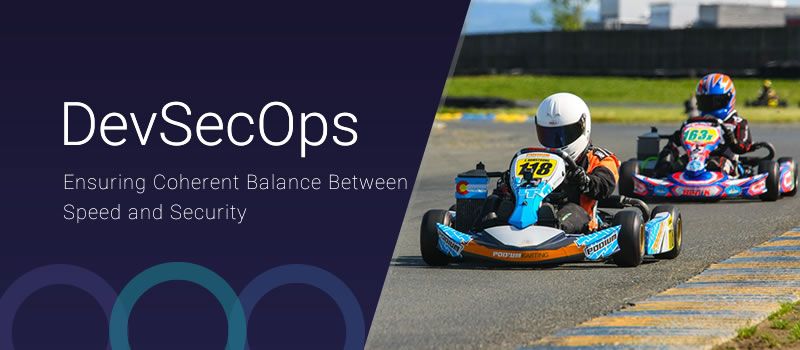 In the recent past, many catastrophic breaches have garnered international attention, the Tesla Cloud hacking is one such that demands mention. Could these exploits have been avoided? Our software development experts assert that these vulnerabilities could have been prevented with basic safeguards reinforced with a healthy dose of DevSecOps. Yet another buzzword! If you have a similar thought, then you have landed on the right page.
In the recent past, many catastrophic breaches have garnered international attention, the Tesla Cloud hacking is one such that demands mention. Could these exploits have been avoided? Our software development experts assert that these vulnerabilities could have been prevented with basic safeguards reinforced with a healthy dose of DevSecOps. Yet another buzzword! If you have a similar thought, then you have landed on the right page.
DevSecOps is a portmanteau of three words – Development, Security and Operations. It is basically described as the integration of security within the DevOps pipeline. In other words, DevSecOps is all about instilling security from conception to deployment in order to create a secure application.
Well, wasn’t security seen as the bottleneck as well as inhibitor of development and deployment? Yes it was, until few practitioners of DevOps methodology advocated about placing security at the forefront of every action in order to ensure data security. Now, let’s try to find answer to this frequently asked question.
Leverage a transparent culture fostered by DevSecOps
Collaborate with our software development team!
How to embrace security without impacting agility?
Do security processes block the agility that empowers you to bring solutions to the market faster? When asked this question, our team of DevOps engineers confirmed that the traditional perception of “DevOps versus security” is just a myth. Today, security has become a key tenant to DevOps practices and you could see the DevOps culture gradually evolving into DevSecOps. Let’s take a look at some of the factors that allowed the integration of DevOps and security in a smooth manner without aggravating tensions between the DevOps and security team:
Automating DevOps security processes and tools
Automation not only reduces the risk of introducing security flaws due to human error but also minimizes downtime and vulnerabilities. You can always identify potential threats, issues associated with infrastructure or processes and vulnerable code by prioritizing the deployment of automated tools.
Thus, you can scale security to your DevOps processes by automating your DevOps security tools for managing configuration, vulnerability, privileged credentials as well as patching and analyzing code.
The cultural resistance to embedding security practices is more likely to arise if you are far from matching the speed of security to the DevOps process. So, by incorporating automated security testing and compliance earlier in the process, you can improve the quality of your software.
Establishing shared responsibility
Collaboration is the guiding principle of DevOps and it corresponds to the idea of shared responsibility. Therefore, developers and security teams must work hand in hand to establish shared responsibility in order to integrate security into DevOps process.
Inter-team knowledge and information sharing must be a continuous process between the security and development teams because it is critical to maintaining shared goals. Moreover, as a custom software development company it empowers us to secure our applications and services with automated solutions.
You might like: DevOps and Cloud: The Synergy Driving Digital Transformation in Enterprises
Enforcing policy and governance
Creating cybersecurity policies that are easy to comprehend for developers and agree to, is essential to the overall security of DevOps processes. This will not only help your teams to meet the security requirements while developing code but also ensure security and compliance throughout the development process.
Therefore, security team can define security and compliance policies while development team embeds them at every step in the CI/CD pipeline. Thus, introducing DevSecOps policies will help you keep up with the pace of application development in a DevOps environment.
Success criteria of DevSecOps
To ensure the success of your DevSecOps initiatives, you would need to meet these standard requirements:
- Establish shared expectations and metrics for evaluating success
- Align security with your business objectives
- Create security policies, monitor compliance with them and provide targeted feedback
- Automate recurring tasks to organize an integrated process flow
- Leverage operational insights to drive process flow
- Rely on risk-based testing rather than security scans
- Implement end-to-end security to protect DevOps pipeline and application as well
- Perform continuous testing to identify problems before they become issues
Key benefits of DevSecOps
- Continuous security: DevSecOps uses security automation for code review and application testing to implement “security by design” principle.
- Increased efficiency: Detecting and fixing security defects in the development phase enhances the speed of delivery.
- Enhanced product quality: Monitoring and remediation of security issues across the application lifecycle increases product quality.
- Enhanced compliance: Core security tasks such as auditing, monitoring and notification are automated which facilitates enhanced compliance.
- Increased collaboration: Fosters a culture of openness and transparency by integrating development, security and operations from the early stage of development.
Achieving speed with security and stability
Organizations that adopt DevSecOps achieve speed without risking security and compliance. By incorporating security practices from the start, you can introduce a security layer that is not only effective, but also viable for your DevOps environment and solutions. This in turn, enhances efficiency, reduces the possibility of data exploits and ensures development of powerful solutions to meet business needs effectively.



